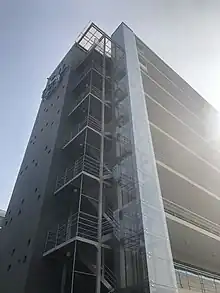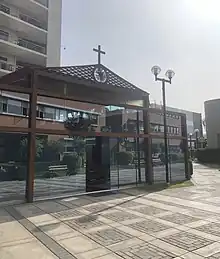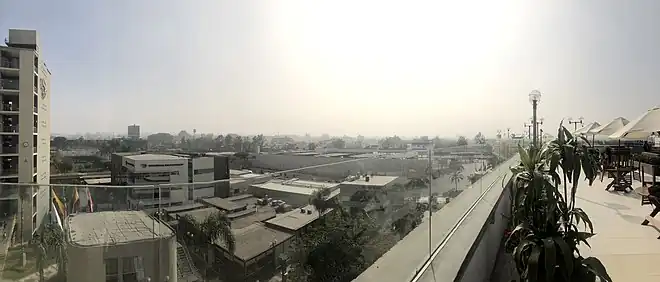Universidad San Ignacio de Loyola
St. Ignatius of Loyola University (Spanish: Universidad San Ignacio de Loyola) (USIL) is a private institution for higher education and research in Lima, Peru. It was founded in 1995, as part of the Educational Corporation San Ignacio de Loyola, by Raúl Diez Canseco. The main campus is based in La Molina district. Four decentralized campuses in Pachacamac, Huachipa, Independencia, and Magdalena, provide additional infrastructure for lectures, research, workshops, and sport facilities. Historically, USIL has focused on business, management, and entrepreneurship;[3] however, in recent years, it has expanded significantly in the fields of Education, Engineering and Health Sciences. By 2023, USIL offers 34 undergraduate and 13 postgraduate programmes in 8 faculties.
Universidad San Ignacio de Loyola (Spanish) | |
 | |
| Motto | Emprendedores que Forman Emprendedores (Spanish) |
|---|---|
Motto in English | Entrepreneurs Educating Entrepreneurs |
| Type | Private Research Coeducational Higher education institution |
| Established | December 7, 1995 |
| Founder | Raúl Diez Canseco Terry |
| Affiliation | Corporación Educativa USIL |
| Rector | Ramiro Salas Bravo[1] |
| Students | 18,763 (2018)[2] |
| Undergraduates | 18,580 |
| Postgraduates | 183 |
| Address | Campus USIL: Av. La Fontana 550, La Molina , , 12.072536°S 76.951656°W |
| Campus | Urban --Fernando Belaúnde Terry Campus --Miguel Grau Seminario Campus |
| Colors | Blue and white |
| Nickname | USIL |
| Website | usil.edu.pe |
History
20th century
The origin of USIL is the San Ignacio de Loyola Academy, which was founded in 1968. The academy provided training for people that were aiming to sit the general examination for admission into Peruvian universities. Lectures were initially given in the parochial hall of Nuestra Señora de Fatima church in Miraflores, by authorization of José Antonio Eguilior, a priest of the Jesuit order. The support given by the Jesuits would shape important aspects of the institution over the years.
In 1983, the educational coorporation expanded and founded the Instituto Superior Tecnológico, a trade school which is no longer part of the corporation.
By the mid-90's, there was a national concern about the limited options to access college education, which led the Peruvian Congress to pass the law DL N°882 to promote private investment in higher education. The new legal framework allowed a financially sustainable project for a new university. In 1995, the National Council for the Authorization of Universities (CONAFU) approved the creation of Saint Ignatius of Loyola University. Lectures started in 1996 for undergraduate programmes focused on Business and Entrepreneurship. The School of Postgraduate Studies was also established in 1996. In 1998, the university founded the School for Chefs "Don Ignacio" and strengthen the hospitality programmes.
21th century
At the start of the 21st century, USIL expanded its academic offer. Additionally, it refined its professional training by inaugurating the Restaurant "Don Ignacio" in La Molina and Hotel "La Casa de Don Ignacio" in Cusco as part of the Faculty of Hospitality. In 2009, the university inaugurated a new campus in northern Lima, followed by the Institute for Entrepreneurship. By 2015, USIL expanded to four campuses across Lima. Additionally, the educational corporation developed centres and colleges in Asunción, Miami, and Beijing. In 2017, the National Superintendence of Higher Education (SUNEDU) granted USIL a new functioning license, confirming the fulfilment of the quality standards established by the new education reform.[4] Since 2020, the university has invested significantly in health sciences, including the establishment of the Institute for Food Sciences and Nutrition and a new undergraduate programme of medicine.

Campuses
La Molina
The main campuses are located in the residential district of La Molina, about 16 km from Lima's downtown. The infrastructure cover approximately 3 hectares and it is walking distance from La Rotonda Mall, restaurants, sport centres and pubs.
Fernando Belaúnde Terry Campus
The first campus was built in the mid-1990 and it's named after the former President of Peru, Fernando Belaúnde Terry. It has an extension of 11,100 m2. Nowadays, it provides infrastructure for the Faculty of HTG and the Faculty Health Sciences. Since 2022, Hall A has been undergoing refurnishment works for its repurposement. Scheduled for inauguration in mid-2023, the multimillion investment aims to provide a platform for academic excellence and cutting-edge research in the Health Sciences programmes.
Miguel Grau Seminario Campus
A second campus in La Molina is named after Miguel Grau Seminario, Peruvian hero in the War of the Pacific. It is based only 200 m away from Fernando Belaunde Terry Campus. It has an extension of 18,600 m2, and provides infrastructure for most faculties, the offices for the School of Postgraduate Studies, the Centre for Global Education and the Chaplaincy. It also provide the environment for most ceremonies and international events.

Pachacamac
The Pachacamac campus has approximately 7 hectares. It is located in Pachacamac district, about 45 km to the south of Lima. It houses multiple laboratories for the Faculty of Engineering, including the Agroindustrial Plant, and the Institute for Food Sciences and Nutrition (ICAN). It is also the main centre for the university's sport facilites.
Lima Norte
It is located in the district of Independencia. The campus provides the facilities for the CPEL programme, a degree-awarding programme designed for adults with professional experience. The Institute for Entrepreneurship operates partially in this campus.
Magdalena
The Magdalena Campus, located in the district of Magdalena del Mar, is the base location for the Institute for Entrepreneurship.
Auxiliary Campus in Huachipa
The Auxiliary Campus in Huachipa, is located in the village Santa María de Huachipa, approximately 30 min from Lima. It has an extension of 2.5 hectares and it is used for sport events, festivals and other general recreation activities for the students and staff.

Organisation and administration
Faculty of Architecture
Faculty of Arts and Humanities
- Commercial art and design
- Music
Faculty of Business
- Business Administration
- Business Administration and Entrepreneurship
- Business Administration and Corporative Finance
- Economics
- Economics and Finance
- Economics and International Business
- International Business
- Marketing
Faculty of Communications
- Communications
Faculty of Education
- Early Childhood Education
- Secondary Education with specialty in English Language
Faculty of Engineering
- Agroindustrial Engineering
- Data Science
- Industrial and Commercial Engineering
- Systems Engineering and Information
- Civil Engineering
- Business Engineering
- Food Industrial Engineering
- Logistics and Transport Engineering
- Environmental Engineering
- Mechanical Engineering
Faculty of Health Sciences
- Physical Activity and Sports Sciences
- Nutrition and Dietetics
- Medicine
- Psychology
Faculty of Hospitality Management, Tourism and Gastronomy
The School of Hospitality Management, Tourism and Gastronomy focuses on hospitality management, tourism management, culinary arts, and gastronomy, and has its own building on USIL's first campus, called Hall E, housing specific facilities for the use of its students, such as mock hotel rooms, bars, kitchens. Hall E is also shared with the Culinary Arts School, which is a different programme, as well as Don Ignacio Restaurant[5]
Faculty of Law
- Law
- International Relations
Academic profile
Notable alumni, faculty and staff
- Raúl Diez Canseco - Founder and President of the Board, Former Vice-president of Peru
- Carlos Boloña - First Rector (1995-2000) and Former Minister of Economy and Finance
- Lourdes Flores Nano - Former Rector (2006-2009), Politician, Former Congresswoman and Former Leader of the Christian People's Party
References
- pe/sites/default/files/estatuto-universitario.pdf "Estatuo Universitario" (PDF) (in Spanish). Universidad San Ignacio de Loyola. Retrieved September 30, 2017.
{{cite web}}: Check|url=value (help) - "Estudiantes USIL" (PDF) (in Spanish). Retrieved December 5, 2018.
- "Ficha Técnica Universidad San Ignacio de Loyola" (PDF) (in Spanish). Retrieved March 21, 2019.
- "SUNEDU OTORGA LICENCIAMIENTO A LA UNIVERSIDAD SAN IGNACIO DE LOYOLA". SUNEDU (in European Spanish). 2017-10-08. Retrieved 2023-04-19.
- "Don Ignacio Restaurant Website". Retrieved March 21, 2019.